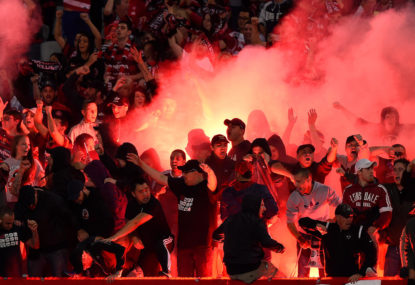Apart from the occasional visit, I have to watch the A-League from afar. This means I haven’t a clue what I am talking about.
Try as I might, I can’t help but see many good – some great – games, played in fantastic stadiums in front of decent crowds and lively atmospheres.
The teams seem to be largely well-coached and well-organised, and there is a whole air of professionalism.
Get online to read about what you have just seen though, and these naive notions are quickly disabused – the game is either rattling forward to a precipice or being dragged back to the Dark Ages.
People surely need to get out a little more.
More football:
» The A-League is at a crossroads
» Some won’t like it, but FFA ban procedure looks fair
» FFA ratify new banning procedure
» Victory CEO says anti-social fans “are not welcome and we do not want them”
» Victory issued show-cause notice for flare up
» Flares are not a football problem, they’re a police problem
Asia would be a good start. Travelling around a few different countries in recent weeks, every one I visited would look at Australia and its league with some envy.
Flares in the stadium? At least there are fans. Last month I was in Abu Dhabi talking to Al Wahda coach Javier Aguirre – former boss of Mexico, Japan, Atletico Madrid and others – about the lack of fans in one of Asia’s leading football nations. His team won to move into third, but while the official attendance was 1200, barely half that were present.
Football is more popular in Thailand, but that brings different problems. The A-League attracts the occasional flare, Thai football attracts more undesirable elements, with some of it genuinely scary. Powerful people get involved.
In three days, I interviewed all the major players in the campaign to elect a new president for the Football Association of Thailand. It made Game of Thrones seem simple and gentle.
That was necessary because Worawi Makudi, president from 2007, had been suspended by FIFA for a breach of ethics. The list of accusations is longer than a Mark Milligan throw, but suffice to say he became loathed by fans and plenty of others. Bribery, intimidation and threats were hanging in the humid air. It was enough to make wannabe A-League hooligans turn faster than Johann Cryuff.
Worawi’s shadow still looms large though. His mate and former coach Charnwit Phalajivin ran for election and lost, but not before telling me from behind a big desk at the Thailand Sports Ministry that defeat just meant the start of many lawsuits. The message from inside the ageing offices of the FAT was the same.
The winner was Somyot Poompanmoung, a government-backed (not too openly, as all were nervous of a FIFA ban like Indonesia and Kuwait), former Thai police chief without much of a football background. Affable and confident, he promised a new start.
Given the craziness of Thai football, the man connected to the military junta was the candidate of reform when running against a well-respected and well-liked former national team coach.
Then to Malaysia, another football-loving country that attracts people that you wish could confine themselves to waving the odd flare.
Some even put money into the game rather than taking it out, but there are often conditions. On the first day of the new league season, there were a number of Aussies in action, but none at Kedah, as Kelantan managed a 0-0 draw on the road. The result was disappointing for the visitors, but that was nothing on what happened in the dugout.
The owner of a well-known cosmetics company had pumped about $6 million into the financially floundering Kelantan. In return, the sponsors – famous for skin-whitening products and other cosmetic items – get to paint the stadium pink, turn the shirts pink (these garments, so the claim goes, also whiten the skin) insert their motto into the team’s nickname and, incredibly, get a seat on the bench for the opening day of the season.
But then there was what could be the best goal of 2016 by way of compensation.
To Seoul, where all should be content as this is Asia’s most successful football country in all manner of fields. Eight successive World Cups is a continental record. Eight successive Olympic appearances is a world record. Ten Asian club titles is easily the best. World Cup semi-finals, players winning UEFA Champions League medals and Olympic podium finishes – it’s all there.
The standard of the K-League is good. Yet the competition has been in the doldrums for a while in terms of media profile and attendances. Decent teams and often small crowds rattling around huge stadiums with authorities almost having to beg to get free-to-air television interested in broadcasting the occasional game.
Most clubs are tightening their belts – Melbourne’s Asian CL opponents Suwon Bluewings recently apologised to their fans for a lack of transfer activity in the close season – at a time when Chinese clubs are really flexing their muscles.
Korea is struggling to deal with the rise of China, struggling to overcome long-held football notions to see the opportunity it presents. There are worries about the new season, the lack of spending and stars, as well as the Asian Champions League.
As I said, recent travels did not take me to Australia, but from the outside looking in, a few flares and mock-menacing stares just don’t seem that bad.





























































































